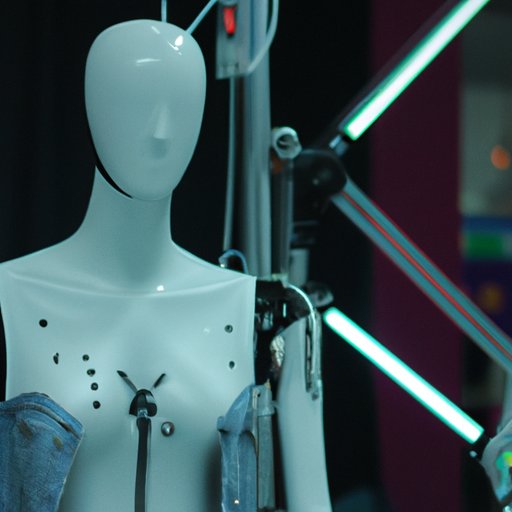Introduction
Fashion technology is the application of technology to the design and production of clothing. It encompasses a wide range of technologies, from 3D printing and artificial intelligence (AI) to virtual reality (VR) and robotics. This technology has revolutionized the fashion industry, allowing for faster, more efficient production of clothing and accessories. By harnessing the power of technology, the fashion industry is able to create innovative designs and keep up with the ever-changing trends.

Overview of the Impact of Technology on the Fashion Industry
Technology has had a profound impact on the fashion industry. From automated production lines to computer-aided design (CAD) software, the use of technology has enabled fashion companies to produce clothing faster and more efficiently than ever before. According to a study conducted by the International Journal of Fashion Design, Technology and Education, “the use of technology has helped to reduce lead times, increase productivity, reduce costs, and improve product quality.”
In addition, technology has allowed for greater creativity in the fashion industry. With the help of computer-aided design software, fashion designers are able to quickly visualize their ideas and bring them to life. As a result, the fashion industry has seen an influx of new and innovative designs that would have been impossible without the help of technology.

Recent Advances in Fashion Technology
The fashion industry is constantly evolving and adapting to the latest advances in technology. Here are some of the most recent advances in fashion technology:
How Technology is Changing the Way We Dress
One of the most exciting developments in fashion technology is the emergence of “smart clothing”. Smart clothing is apparel that is embedded with sensors and other technology that can track biometric data such as heart rate, body temperature, and movement. This technology allows for a more personalized experience when it comes to dressing, as it can be used to tailor clothing to the individual’s body type and preferences.
Another advance in fashion technology is the use of 3D printing. This technology enables fashion designers to quickly and easily create prototypes of their designs without having to invest in expensive molds or materials. Additionally, 3D printing can be used to create custom-made garments that are tailored to a customer’s exact measurements.
Understanding the Role of Technology in Smart Clothing Design
One of the key elements of smart clothing design is the integration of sensors and other technology into the fabric. According to a study published in the International Journal of Computer Science, “sensors embedded in the fabric can monitor and record various parameters such as body temperature, heart rate, and movement. The data collected by these sensors can then be analyzed to determine the wearer’s activity level and provide feedback to the user.”
In addition, technology can be used to create fabrics that are more comfortable and durable. For example, fabrics that incorporate nanotechnology can be made to be water-resistant, breathable, and stain-resistant. These advances in fabric technology can make clothing more comfortable and durable, while also reducing the need for frequent washing and ironing.

Benefits of Wearable Technology in the Fashion Industry
Wearable technology has revolutionized the fashion industry, providing a wide range of benefits. Here are some of the potential benefits of using wearable technology in the fashion industry:
Keeping Up with the Latest Trends in Fashion Technology
The fashion industry is always changing and evolving, and it’s important for fashion companies to stay up to date with the latest trends in technology. Wearable technology can help fashion companies stay ahead of the curve, as it enables them to quickly and easily develop new products that are tailored to current trends. Additionally, wearable technology can give fashion companies insight into consumer preferences, allowing them to tailor their products to the needs of their customers.
Exploring the Potential Benefits of Wearable Technology
In addition to staying up to date with the latest trends, wearable technology can also provide a wide range of potential benefits to fashion companies. For example, wearable technology can be used to track inventory levels and order fulfillment, as well as monitor customer satisfaction. Additionally, wearable technology can be used to provide real-time feedback to customers, allowing them to make informed decisions about their purchases.
The Future of Fashion Technology
The fashion industry is constantly evolving and adapting to the latest advances in technology, and the future of fashion technology looks bright. Here are some predictions for the future of fashion technology:
What’s Next for Fashion Technology?
The next frontier for fashion technology is likely to be the development of “smart fabrics”. Smart fabrics are fabrics that are embedded with sensors and other technology that can track biometric data such as heart rate, body temperature, and movement. This technology could be used to create clothing that is tailored to the individual’s body type and preferences. Additionally, this technology could be used to provide real-time feedback to customers, allowing them to make informed decisions about their purchases.
Predictions for the Future of Fashion Technology
In addition to the development of smart fabrics, the future of fashion technology is likely to include the integration of AI and robotics into the fashion industry. AI and robotics could be used to automate the production process, allowing fashion companies to produce clothing faster and more efficiently. Additionally, AI and robotics could be used to create custom-made garments that are tailored to a customer’s exact measurements.
Conclusion
In conclusion, fashion technology has revolutionized the fashion industry, enabling fashion companies to create innovative designs and keep up with the ever-changing trends. Recent advances in fashion technology have included the development of smart clothing and 3D printing, as well as the integration of sensors and other technology into fabrics. Additionally, wearable technology has provided a range of potential benefits to fashion companies, from tracking inventory levels to providing real-time feedback to customers. Lastly, the future of fashion technology is likely to include the development of smart fabrics and the integration of AI and robotics into the industry.
Through the use of technology, the fashion industry has been able to innovate and stay ahead of the curve. As technology continues to evolve, so too will the fashion industry, as fashion companies strive to create new and exciting designs.
(Note: Is this article not meeting your expectations? Do you have knowledge or insights to share? Unlock new opportunities and expand your reach by joining our authors team. Click Registration to join us and share your expertise with our readers.)
